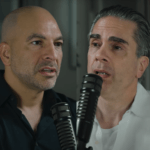In this “Ask Me Anything” (AMA) episode, Peter and Bob dive deep into nicotine, a complicated and interesting molecule that has effects on both the brain and the body. They analyze the results of the studies that describe nicotine’s cognitive benefits and potential for inducing weight loss. They talk about a smoking cessation technique called nicotine replacement therapy and give a full breakdown of the various routes of administration, dosing, and safety. Finally, they explore the fascinating and counterintuitive observation that cigarette smokers are less likely to get a severe case of COVID-19.
If you’re not a subscriber and listening on a podcast player, you’ll only be able to hear a preview of the AMA. If you’re a subscriber, you can now listen to this full episode on your private RSS feed or on our website at the AMA #23 show notes page. If you are not a subscriber, you can learn more about the subscriber benefits here.
AMA #23 Sneak Peak:
We discuss:
- How Peter first became interested in the potential benefits of nicotine [1:15];
- Untangling nicotine from tobacco [6:00];
- Nicotine replacement therapy (NRT) for quitting smoking: products, protocols, and a review of the literature [9:30];
- The cognitive benefits of nicotine: Overview of the literature [15:50];
- Where nicotine has the most positive impact on cognition [30:30];
- Possible mechanisms conferring the benefits of nicotine [37:00];
- How modafinil and other nootropics compare to nicotine [47:15];
- How nicotine may induce weight loss [54:00];
- Relationship between smoking and COVID-19: Analyzing the observation that smoking appears protective against COVID-19 [1:01:45];
- Breakdown of the various nicotine replacement therapies: route of administration, dosing, and safety [1:11:30];
- Concluding thoughts on nicotine: use cases, addictive properties, and more [1:19:45]; and
- More.
*WATCH A PREVIEW OF AMA #23 ON YOUTUBE*
How Peter first became interested in the potential benefits of nicotine [1:15]
Quick aside on Peter’s deadlift routine:
- Peter deadlifts in more the sumo (straight bar) and well as hex bar
- His current phase of deadlifting leans more sumo style rather than hex bar
- He’s using a traditional narrow stance straight bar
- But he goes in phases and likes to mix it up
“This silly unrealistic question of, ‘If you’re going to do one exercise, what would it be?’ That would definitely be variations of deadlifts.” —Peter Attia
Nicotine questions for today:
- Does nicotine improve cognition?
- Does nicotine improve fat oxidation and can it actually help with weight loss?
- Is it possible that smoking is protective against COVID-19?
When peter got interest in nicotine:
- From a personal standpoint, Peter became interested in nicotine about 11 years ago
- He realized that if you could strip away the addictive nature of nicotine, the actual molecule was quite interesting
- He started chewing nicotine gum intermittently
- Note: If you’re not a smoker, go really easy with gum or lozenges because it can make you quite nauseous
- For about the next three or four years, he was on and off nicotine gum somewhere between four and eight milligrams a day and found it to be quite beneficial in terms of his mental focus
- And he never really felt even a slight bit of addiction (not the case for all people)
- More recently, Peter discovered nicotine containing pouches
- He always thought the gum tasted gross (too much sugar/sweetness) whereas the pouches are mostly flavorless
- With the pouches, you’re just basically just getting a pretty high dose of nicotine and it’s bypassing the liver so it actually hits you quicker
Untangling nicotine from tobacco [6:00]
Difference between nicotine and tobacco
Tobacco
- Obviously cigarettes contain leaves from tobacco plants and tobacco also contains nicotine
- Tobacco is actually in the nightshade family of plants, and when you look at potatoes and tomatoes and eggplants, there’s nicotine in there but at nowhere near tobacco
- Nicotine makes up about 1% to 3% of the dry weight of tobacco whereas these nightshades, it’s millions of a percent
Nicotine is not a carcinogen
- The US Surgeon General indicated that there’s inadequate evidence to infer a causal relationship between nicotine exposure and risk for cancer
- But this is counterintuitive when you think about how bad for you smoking is — since nicotine is in there, and it’s addictive, it’s normal to think that it’s one of the carcinogens in cigarettes
- But even the U.S. Department of Health’s list of 69 potential and known carcinogens in cigarettes, nicotine is not one of them
- In other words, nicotine—which has some benefits—unfortunately has that addictive part of it which keeps people coming back to smoking tobacco, but in and of itself it doesn’t cause cancer
- This is important to note because the U.S. Department of Health goes as far to say that processed meat is a class one carcinogen, and red meat is in the next class down as a carcinogen despite very little evidence
“If they can’t even recognize nicotine is carcinogenic given their sensitivity for identifying carcinogens, the likelihood that it has any cancer causing properties is approaching…zero.” —Peter Attia
Nicotine replacement therapy (NRT) for quitting smoking: products, protocols, and a review of the literature [9:30]
NRT – Nicotine replacement therapy
- Nicotine is an addictive substance and so you could implicate that as getting people to smoke and stay smoking
- But now, they’re actually using nicotine to help people quit smoking
- There’s an entire industry of nicotine gum, lozenges, pouches, patches, etc.
A review by the Cochrane Collaboration
- Looked at people who have quit for six months and haven’t returned to smoking
- They found high quality evidence that this NRT increases the chances of successfully quitting smoking by about 50% to 60% (relatively)
- However, in absolute terms: Absolute quit rate at 6 months is ~ 3-5%, and therefore NRT may increase the rate by 2-3%
- “You have to always ask the question, ‘What does that mean at an absolute level?’” says Peter
- In the big picture, the small absolute increase tells us that it is very hard to quit smoking using NRT
Why doesn’t it work more?
-
- Bob says the lozenges for the most part come in two milligram and four milligram
- But a cigarette supposedly has about one milligram of nicotine contained within the cigarette
- But… it’s a different route of administration and people probably say something to the effect of “it’s just not the same” and they go back to the smoking
- Is inhalation just the fastest route of administration making the rush and the buzz from the nicotine when you inhale it across that entire alveolar surface area?
-
- I think that plays a role, says Bob
- They’re working on patches and nasal sprays trying to mimic getting speedier delivery of it
Historical smoking data
- At its peak in the mid 1960s, close to 60% of Americans over the age of 18 smoked cigarettes
- Now, Americans that smoke is around 15%
- Interestingly, in the podcast with Nir Barzilai, he was talking about centenarians and discussing whether it is their genes or their environment causing them to live so long
- His basic conclusion is that it’s genes, not environment, citing that a lot of the centenarians had smoked
*One protocol that’s possibly more successful than just NRT for smokers trying to quit: Combining Wellbutrin, an antidepressant, with NRT
“If you’re a smoker and you’re interested in longevity, there’s harder to find a lower hanging piece of fruit than smoking cessation as you move to improve someone’s health.” —Peter Attia
The cognitive benefits of nicotine: Overview of the literature [15:50]
A meta-analysis from 2010
- They found 41 studies (48 experiments) where there were sufficient effect size data (i.e., a minimum of five effect sizes from independent studies were available) to conduct meta-analyses on nine performance domains, including motor abilities, alerting and orienting attention, and episodic and working memory.
- When you do a meta-analysis, there’s usually an inclusion criteria and an exclusion criteria — In this case they only looked at the double-blind placebo-controlled trials on nicotine and smoking on human performance (i.e., attention and cognition) in healthy adult nonsmokers and smokers who were not tobacco deprived
- Regarding the “not tobacco deprived” criteria — they are making sure that the smokers were not coming to the study already in a state of low cognition due to withdrawal symptoms
- For example, if you tell a heavy smoker to not smoke in the morning, their cognitive performance may actually decline just because of that, because they’re going through nicotine withdrawal
{end of show notes preview}






As a former, degenerate smoker (1+ pack per day) who had _many_ failed attempts to quit, I wanted to add something to the conversation regarding on-label use of NRT.
I tried NRT products, many times, and could quit for days or weeks but never more than a month or two.
What finally worked was completely unexpected – reading a book “Allen Carr’s Easy Way to Stop Smoking.” If you believe the testimonials (and I am one), it is staggeringly effective compared to any alternative methods.
I’m 5 years smoke free at this point.
This was such a fascinating talk, but I’m disappointed that you didn’t discuss healing and blood flow. I recently quit vaping, mostly for health (and COVID concerns), but also due to noted issues with healing. I’d love to hear your thoughts about research possibly separating smoking and vaping from nicotine. I believe there are studies on post-surgical patients comparing smoking to NRTs and finding similar effects on wound healing. Can you comment?
Great episode. In a future episode or during your next Q&A session, it would be interesting to expand this discussion to include nicotine as a therapy for ulcerative colitis, IBD, and Crohn’s disease.
Is there a preference between nicotine gum/lozenges (e.g. Nicorette) or nicotine pouches (e.g. Zyn/Velo) from the gas station (or are these the Wild West)? Is there additional regulation on the Nicotine Replacement Therapy options like gum/lozenges that make them a better choice, or is the gas station option an equal choice? Thanks
Also, would like to hear which lozenges Peter and Bob take.
Thanks.
I would as well. Lucy seems to be popular, but they are flavored and I’d like to avoid additives.
I second that. I think Peter was saying he had a pouch. I like the Lucy lozenges
for me, I didn’t like the Nicorette loz, the generic Walmart brand I like in a pinch. I like the Lucy brand loz best, they got a few new flavors that are great.
Interesting AMA. I’ve just started to experiment with nicotine gum to enhance my performance in Action Pistol Shooting sports and was very curious to hear if that type of activity would make the list of “use cases” promised in the show notes.
Unfortunately, even though “Use Cases” shows up in the show notes twice there was no actual discussion about this. Seems like a big oversight. What’s the point of all that discussion of studies and data without some guidance on when NRT might be useful.
Curious about the safety of Snus. I use that when I go on my long 10-mile walks as a way to keep my mind a bit distracted. Technically it is tobacco and would possibly fall under the category of dip though I assume it’s much less concentrated.
Very interesting podcast, but I’m quite surprised you didn’t discuss the effect of nicotine on the cardiopulmonary system. I suspect this drug would be put in the category of improving performance but not longevity.
Enjoyed this episode and decided to give nicotine lozenges a try. Try first research later. Probably not the wisest approach but found this article from on nih.gov which lays out possible harmful effects of nicotine as a stand alone substance:
https://www.ncbi.nlm.nih.gov/pmc/articles/PMC4363846/
Would be interested to here a “words of caution” episode on the nicotine as a follow up.
Would like to hear which lozenges Peter and Bob take.
One hypothesis (as stated in the AMA) is that the increased nitric oxide (NO) from smoking may inhibit SARS-CoV-2, therefore, have some protective downstream benefits from contracting COVID.
Thinking out loud (and at you, Peter): I wonder what the implications of nose breathing (popularized in Breath by James Nestor and The Oxygen Advantage by Patrick McKeown) may be as it relates to the (potential) protection from COVID?
NO is produced in the paranasal sinuses through nose breathing and is excreted continuously into the nasal airways and into the lungs and organs. Pretty interesting.
Hey Peter,
Great episode! It was actually this episode that triggered me to subscribe.
I have a question around nicotine for active people (weight training 3x/week + cardio 1-2x/week).
My question is around the benefits of nicotine for weight loss and sustaining that weight loss.
If nicotine mobilizes fat cells and enables and increase muscle LPL activity, then wouldn’t some sort of nicotine therapy or occasional use increase muscle gain over time. Furthermore, if mobilization of fat in bad places like stomach fat is increased, and those fats are transferred to the muscles then that would essentially help with weight loss and weight sustainability.
For example, someone looking to lose 30lbs and maintain it begins a form of nicotine therapy they would achieve their goal in a shorter period of time than someone with the some goal and not using nicotine therapy. In addition, the sustained use of nicotine therapy would help them sustain their goal weight versus those not on nicotine therapy.
Curious to hear what your thoughts are.
Again the key here being that someone who is active consistently. Curious about what your thoughts are on that.
It’s been mentioned by a few people, but I’d be curious to hear your thoughts on the effect of nicotine on blood pressure. As someone who is working on getting healthy to improve my blood pressure (among other things), I won’t be using nicotine any time soon given what I’ve seen, but I’d be curious to see you and Bob address it.
Re: Dose-response relationships
Many small molecules display nonlinear dose-response relationships. This is particularly true for small molecules with CNS activity, as often, the effects we are interested in represent the end product of multiple ‘separate’ (but superimposed) molecular cascades. Moreover, depending on location, what may effectuate a cascade (and fire a circuit) in one area of the brain, may do something else entirely in another.
For example:
If risperidone dosage is plotted against efficacy in treating schizophrenia, we observe a positive correlation until reaching (approximately) the 8mg/24hr threshold. However, rather than plateauing, further uptitration results in reduced efficacy. That is to say, (on average) 12 mg is less efficacious than 8mg (PMID: 31838873). As such, the agent displays a bell-shaped dose-response curve. Note: the soporific profile of many CNS drugs follow similar kinetics.
While multiple mechanisms drive this phenomenon, two important factors to consider are
1) The concentration of a ligand needed to generate an action potential in one area of the brain is likely to differ from region to region. Further, various portions of the brain receive different concentrations of drug (dependent on both tissue composition and molecular makeup of the agent).
2) Different neurons can share extracellular binding domains (same receptor) though differ in second messenger system.
3) Ligands are often messy, activating/inhibiting multiple types of receptors. Thus, the effect of interest is often the superimposition of multiple molecular cascades (cholinergic, dopaminergic, histaminergic, etc.), located in different regions of the brain, activated at varying concentrations.
I was disappointed in the discussion of vaping and the reliance on FDA data to the exclusion of other public health authorities work on the subject. Public Health England has done and published extensive research on the risks of vaping, and their estimate is that it is 95% safer than smoking. In my small circle, I know of three smokers who have 100% quit smoking for years by vaping, when other quit methods have failed. PHE actively uses vaping as a quit protocol. Would love to have Peter’s comments on this data source.
Hei, great podcast I would like to hear the same deep dive into Caffeine.
After listening to episode #166 with Patricia Corby and hearing about your love of toothpicks, I wanted to clue you in on nicotine toothpicks, if you haven’t already looked into them. I personally like the Spice Island Clove flavor toothpicks from Zippix – no affiliation.